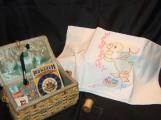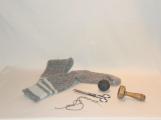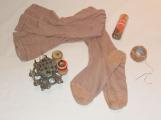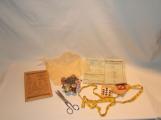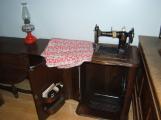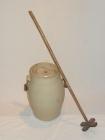2
With the homemaker's daily chores completed, mending the newly ironed clothing took place. It was in ironing one discovered the need to replace buttons, add a patch or two, repair a seam, etc.4
There also seemed to be an endless pile of socks to mend! These types of socks were priced at 3 pr. for 55 cents. The darner's price was 20 cents. Some homemakers used a tea cup instead and it was as efficient. The darner or tea cup would be inserted into the sock and held under the hole as an aid to make a smooth woven patch.6
There was also a need to make family clothing, as the cost to purchase was prohibitive, and the availability was not always readily possible. This activity generally took place in the kitchen so that the homemaker could keep an eye on the progress of the next meal cooking on the stove. The Lisle stocking cost 50 cents and the mending thread was 11 cents for two spools.8
The nearest general store or the mail order catalogue would have the necessary sewing notions. A Butterick pattern was 25 cents.10
Lot of the patching was done by hand or it could be done by a treadle sewing machine. There was adult clothing and most of the children's clothing was made at home. The cost of a treadle machine was $28.00.12
Butter making happened whenever the homemaker had collected enough excess cream after personal use. This activity could happen anytime during the week. The butter churn would be brought from its storage and placed in the kitchen. Lots of time was spent with the dasher that agitated the cream to turn it into butter. This stone ware with dasher cost $1.10 up.14
Q:There have been many changes to technology in the kitchen over the last century, affecting everything from how you clean dishes to how to prepare meals. One of the more apparent changes was in how you acquired a simple ingredient like butter. Give a brief breakdown on how butter was made.
Q:To make butter you had to save enough cream - 2 or 3 gallons which depended on the size of your churn. You would churn the cream until the butter was formed. Then you would drain the butter milk. The butter had to be washed three or four times in very cold water then salt it. You could put the excess butter into a butter form that made a pound (500 grams). Then wrap it in butter paper then bring to the grocery store to trade or sell for groceries.
